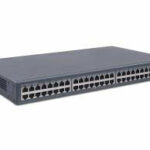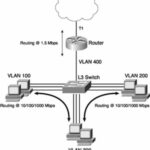 What is the difference between a Layer-3 switch and a Router :-
What is the difference between a Layer-3 switch and a Router :-
A Layer 3 switch works much like a router because it has the same IP routing table for lookups and it forms a broadcast domain. However, the “switch” part of “Layer 3 switch” is there because:-
- The layer 3 switch looks like a switch. It has 24+ Ethernet ports and no WAN interfaces.
- The layer 3 switch will act like a switch when it is connecting devices that are on the same network.
- The layer 3 switch is the same as a switch with the router’s IP routing intelligence built in.
- The switch works very quickly to switch or route the packets it is sent.
Layer 3 Switch is really like a High-Speed Router without the WAN connectivity. When it comes to Layer 3 Switching, there are two kinds: hardware and software. With a hardware-based solution, the device is using an ASIC (A Dedicated Chip) to perform the function. With the software implementation, the device is using a computer processor and software to perform the function. Generally, Layer 3 Switches and High-End Routers route packets using Hardware (Asics) and General-Purpose Routers Use Software to Perform Routing Functions.
In General, A Layer-3 Switch (Routing Switch) Is Primarily A Switch (A Layer-2 Device) That Has Been Enhanced Or Taught Some Routing (Layer 3) Capabilities. A Router Is A Layer-3 Device That Simply Do Routing Only. In The Case Of A Switching Router, It Is Primarily A Router That Uses Switching Technology (High-Speed Asics) For Speed And Performance (As Well As Also Supporting Layer-2 Bridging Functions).
Why we need a Layer 3 switch:-
- Network with a lot of broadcasts that needs better performance.
- Subnets and/or VLANS that are currently connected Via a router.
- Higher Performance VLANS.
- Departments Need Their Own Broadcast Domains For Performance Or Security.
- Considering Implementing VLANS.
Difference between a Layer-3 switch and a Router :-
- Performance versus Cost— Layer 3 switches are much more cost effective than routers for delivering high-speed inter-VLAN routing. High performance routers are typically much more expensive than Layer 3 switches.
- Port density— Layer 3 switches are enhanced Layer 2 switches and, hence, have the same high port densities that Layer 2 switches have. Routers on the other hand typically have a much lower port density.
- Flexibility— Layer 3 switches allow you to mix and match Layer 2 and Layer 3 switching, meaning you can configure a Layer 3 switch to operate as a normal Layer 2 switch, or enable Layer 3 switching as required.
- Layer 3 Switch is used to route traffic between Ethernet networks, without having to worry about the complexities of supporting WAN technologies such as Frame Relay or ATM. Routing over WAN networks, simply by plugging a traditional router that connects to the WAN networks into the LAN network.
- The key difference between Layer 3 switches and routers lies in the hardware technology used to build the unit. The hardware inside a Layer 3 switch merges that of traditional switches and routers, replacing some of a router’s software logic with hardware to offer better performance in some situations.
Some key Points about Layer 3 Switch :-
- Layer 3 Switches Are Used Primarily For Inter-VLAN Routing.
- Layer 3 Switches Don’t Have WAN Connectivity
- The Layer 3 Switch Looks Like A Switch. It Has 24+ Ethernet Ports And No WAN Interfaces.
- The Layer 3 Switch Will Act Like A Switch When It Is Connecting Devices That Are On The Same Network.
- The Layer 3 Switch Is The Same As A Switch With The Router’s IP Routing Intelligence Built In.
- The Switch Works Very Quickly To Switch Or Route The Packets It Is Sent.
This tutorial is dedicated to my friend Anuj Aryan who asked me to write about this topic.
Hope you like my post.What is the difference between a Layer-3 switch and a Router. Please Share with others.
Also Check :-
Basic Configuration required to access Internet through Cisco Router
The OSI Model’s Seven Layers Defined and Functions Explained
Basic Header Comparison between IPv4 and IPv6
What is Transmission Control Protocol (TCP )
What is differences between TCP and UDP




